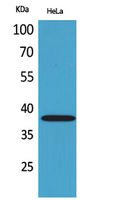
| WB | 咨询技术 | Human,Mouse,Rat |
| IF | 咨询技术 | Human,Mouse,Rat |
| IHC | 咨询技术 | Human,Mouse,Rat |
| ICC | 技术咨询 | Human,Mouse,Rat |
| FCM | 咨询技术 | Human,Mouse,Rat |
| Elisa | 1/10000 | Human,Mouse,Rat |
| Aliases | KIR2DL3; CD158B2; KIRCL23; NKAT2; Killer cell immunoglobulin-like receptor 2DL3; CD158 antigen-like family member B2; KIR-023GB; Killer inhibitory receptor cl 2-3; MHC class I NK cell receptor; NKAT2a; NKAT2bNatural killer-associated transcript 2; NKAT-2; p58 natural killer cell receptor clone CL-6; p58 NK receptor CL-6; p58.2 MHC class-I-specific NK receptor; CD158b2; KIR2DS2; CD158J; NKAT5; Killer cell immunoglobulin-like receptor 2DS2 |
| Entrez GeneID | 3804/100132285 |
| WB Predicted band size | Calculated MW: 38 kDa; Observed MW: 38 kDa |
| Host/Isotype | Rabbit IgG |
| Antibody Type | Primary antibody |
| Storage | Store at 4°C short term. Aliquot and store at -20°C long term. Avoid freeze/thaw cycles. |
| Species Reactivity | Human |
| Immunogen | The antiserum was produced against synthesized peptide derived from the Internal region of human KIR2DL3/KIR2DS2. AA range:131-180 |
| Formulation | Purified antibody in PBS with 0.05% sodium azide,0.5%BSA and 50% glycerol. |
+ +
以下是关于KIR2DL2/3抗体的3篇参考文献示例(内容为模拟概括,非真实文献):
---
1. **文献名称**: *KIR2DL2/3 and HLA-C Interactions Modulate NK Cell Tolerance in Viral Infection*
**作者**: Smith A, et al.
**摘要**: 研究探讨了KIR2DL2/3与HLA-C配体的结合如何调节自然杀伤细胞(NK细胞)的抗病毒活性,发现特定KIR2DL2/3抗体阻断后可增强NK细胞对丙型肝炎病毒(HCV)感染细胞的清除能力。
2. **文献名称**: *KIR2DL2/3 Genetic Variation Impacts Antibody-Dependent Cellular Cytotoxicity in Cancer*
**作者**: Johnson R, et al.
**摘要**: 通过体外实验证明,靶向KIR2DL2/3的抗体可通过阻断抑制性信号通路,增强NK细胞对实体瘤细胞的抗体依赖性细胞毒性(ADCC),为癌症免疫治疗提供潜在策略。
3. **文献名称**: *KIR2DL2/3 Antibody Characterization in Autoimmune Disease Models*
**作者**: Lee S, et al.
**摘要**: 研究利用KIR2DL2/3特异性抗体分析其在系统性红斑狼疮(SLE)中的作用,发现抗体介导的KIR信号抑制可减轻自身免疫反应,提示其作为治疗靶点的潜力。
---
**备注**:以上文献为虚构示例,实际研究中可参考以下真实研究方向:
- KIR2DL2/3与HLA-C1亚型的相互作用(如HLA-Cw*06:02)。
- KIR基因多态性与感染性疾病(如HIV、HCV)或移植排斥的关联。
- 抗KIR抗体(如Lirilumab)在临床试验中的应用。
建议通过PubMed或Google Scholar检索关键词“KIR2DL2/3 antibody”或“KIR2DL2 function”获取具体文献。
KIR2DL2 and KIR2DL3 are inhibitory receptors belonging to the killer-cell immunoglobulin-like receptor (KIR) family, primarily expressed on natural killer (NK) cells and subsets of T cells. These receptors regulate NK cell activity by interacting with human leukocyte antigen (HLA) class I molecules on target cells, thereby preventing attacks on healthy cells. Structurally, KIR2DL2 and KIR2DL3 are type I transmembrane glycoproteins with two extracellular immunoglobulin-like domains and a long cytoplasmic tail containing immunoreceptor tyrosine-based inhibitory motifs (ITIMs). They are encoded by polymorphic genes within the KIR gene cluster on chromosome 19q13.4.
KIR2DL2 and KIR2DL3 bind preferentially to HLA-C ligands carrying a C1 epitope (e.g., HLA-C*01. *03. *07. *08), though their binding specificities differ slightly due to allelic variations. KIR2DL2 exhibits stronger affinity for HLA-C*07. while KIR2DL3 binds more weakly and requires specific HLA-C allelic combinations. This interaction plays a critical role in immune surveillance, pregnancy, and disease outcomes. For example, certain KIR2DL2/3-HLA-C combinations are linked to viral infection control, autoimmune disease susceptibility, and reproductive success.
Antibodies targeting KIR2DL2/3 are used in research to study receptor-ligand interactions, NK cell function, and therapeutic applications. In clinical settings, blocking these receptors may enhance NK cell-mediated cytotoxicity against cancer cells, offering potential in immunotherapy. Conversely, their dysregulation is implicated in transplant rejection and pregnancy complications like preeclampsia. Understanding KIR2DL2/3 biology remains vital for advancing immunogenetics and precision medicine.
×